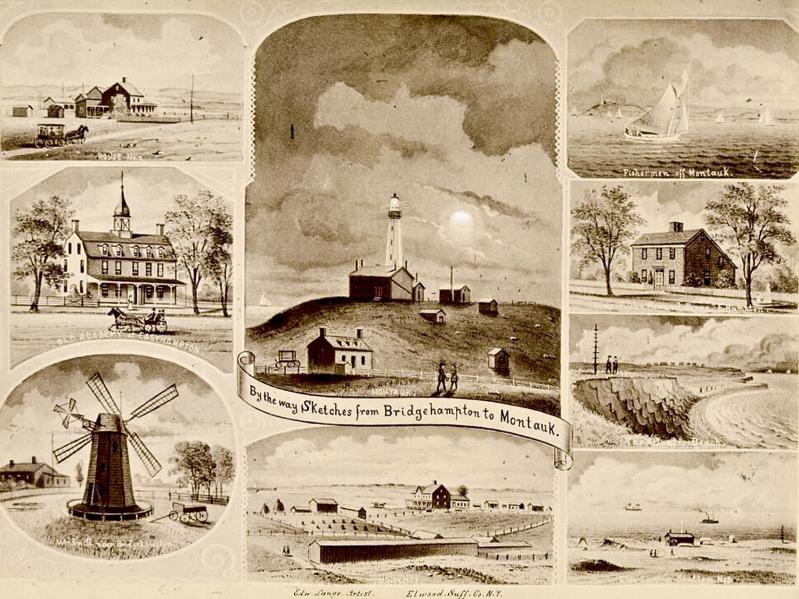“Promoting Long Island: The Art of Edward Lange, 1870-1889”
Lauren Brincat and Peter Fedoryk, Editors
Preservation Long Island, $65
This is a beautifully illustrated luxury publication about an artist and his work, but also a history of the expansion of development on Long Island in his time. It is, I think, of interest to our readers here on the East End as it casts a long shadow across our present-day panoramas.
Edward Lange, an educated German immigrant who fled midcentury European revolutions, arrived on Long Island in 1870, when he started illustrating private properties, farms, villages, and trades, which he drew in pencil or India ink and enriched in colorful watercolor and gouache. These picturesque and popular images were often reproduced for sale in albumen photographic prints — many of which appear in this volume.

Brooklyn Public Library, Center for Brooklyn History
These scenic images are slightly innocent, a trifle primitive in character. As Jennifer L. Anderson, a Ph.D. associate professor of history at Stony Brook University and author of one of the essays in the book, comments: “At the time, neither Lange’s patrons nor contemporary art critics found fault with his pleasing (if inaccurate) renderings of Long Island scenes. If we credit him today with unusual powers of observation, however, we must acknowledge that his image-making was highly subjective and evaluate the meaning and significance of his selective vision.” In other words, they are rendered in exquisite detail with “the grittier aspects” left out.
This takes us to the meaning of the publication’s title: “Promoting Long Island,” for it seems that Edward Lange was “an artist by trade but an entrepreneur by profession.” His aim was to promote and advertise Long Island, says Peter Fedoryk of the University of Delaware. “In the late nineteenth century, Lange’s artwork had immense visual influence in the New York metropolitan area. . . .”
“Over the two decades that Lange lived there (between 1870 and 1889), Long Island’s rural landscape and agricultural economy were substantially transformed by the urban forces emanating from New York City’s and Brooklyn’s metropolitan hubs to the west.”
Notably, Lange depicted large resort hotels developed by Austin Corbin on the North and South Shores of Long Island for promotional purposes as the Long Island Rail Road extended its reach from New York to Montauk between 1881 and 1895. (Corbin was also head of the L.I.R.R.) The hotels were located in places like Manhattan Beach, Bay Shore, Babylon, Fire Island, Cold Spring Harbor, Llyod’s Neck, Massapequa, and Shelter Island — all reachable by the lengthening railroad and none of which appear to have survived to this day.
The L.I.R.R. reached Sag Harbor in 1869, Bridgehampton in 1870, and Montauk in 1895 (remember Teddy Roosevelt and his Rough Riders quarantined there in 1898 after returning from Cuba).
“Promoting Long Island” has a good deal to say about Lange’s work in Sag Harbor. On page 85, an albumen photo print of the village (the book contains composite portraits of a half-dozen other Long Island villages and hamlets) appears with a very recognizable panoramic view of the harbor at its center and vignettes of local monuments top and bottom, notable among them the Old Whalers Church, with its tall spire intact, and the Fahy’s watchcase factory at the site of today’s Watchcase Condominiums.
Again, as these pictures are in fact advertisements, it seems the images have been wiped clean of negativities. Apparently, “Fahy’s Watch Case Factory [the village’s largest employer at the time] had a troubled safety record.” Soon, “reports regularly circulated of gruesome accidents and maimed workers. . . .”
Another composite image local readers might enjoy is on page 114, titled “By the Way Sketches from Bridgehampton to Montauk.” Some of its vignettes depict the familiar Lighthouse, a windmill in Bridgehampton, and Clinton Academy in East Hampton.
But the underlying theme of this book is the illustrated story of urban encroachment on Long Island’s rich landscape. It presents Lange as the agent of developers who were growing rich at the expense of the bucolic farms that covered the land when Lange started portraying them in 1870, foreshadowing what we see around us in the Hamptons today.
Ana Daniel, retired from business consulting and academia, regularly reviews books for The Star. She lives in Bridgehampton.

